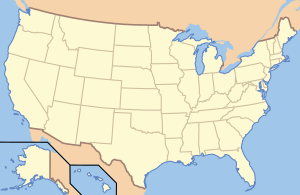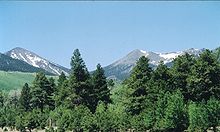Coconino National Forest
|
Coconino National Forest
|
|
|
Cathedral Rock at Red Rock |
|
| location | Arizona , USA |
| surface | 7,511 km² |
| Geographical location | 35 ° 13 ' N , 111 ° 40' W |
| Setup date | July 2, 1908 |
| administration | US Forest Service |
The Coconino National Forest is a national forest around the cities of Flagstaff and Sedona in northern Arizona .
geography
The elevation is between 800 m on the Verde River and 3851 on Humphreys Peak . A large part of the area is high plateau with around 2100 m in height, which is bordered in the south by the Mogollon Rim . The National Forest is bounded by four other National Forests ( Kaibab in the west, Prescott in the southwest, Tonto in the south and Apache-Sitgreaves in the southeast) and consists of four different districts.
Peaks District
The Peaks District includes the San Francisco Peaks with the highest mountains in Arizona, including Humphreys Peak at 3851 m. They are part of the 4700 km² San Francisco volcanic field , much of which is in the National Forest. The volcanic field includes various geological formations such as B. Cinder cones and lava tubes ( Lava River Cave ). Within the Peaks District lie the three national monuments Sunset Crater , Walnut Canyon and Wupatki , the latter on the northeast border of the district.
Red Rock District
The Red Rock District includes the area around Sedona with its hard rock , table mountains and canyons , such as. B. the Sycamore Canyon . Sedona, along with Oak Creek Canyon and the nearby Slide Rock State Park, is a popular destination and therefore of tourist importance. This area is a little lower than the rest of the National Forest, which is why temperatures rise more in summer.
Mormon Lake District
The Mormon Lake District is located south of Flagstaff and includes not only the eponymous Mormon Lake but also other lakes, such as B. Ashurst Lake or Marshall Lake . The Anderson Mesa Station of the Lowell Observatory is also nearby. In the southwest of the area are the two narrow reservoirs Upper Lake Mary and Lower Lake Mary . While the former is still filled with water in the summer months, the latter turns into a wet meadow in the summer months .
Mogollon Rim District
The Mogollon Rim District is geographically similar to the Mormon Lake District. It also includes many small lakes and streams that flow through the large yellow pine forests . South of the district is the Tonto National Forest.
history
In 1898 the then US President William McKinley placed an area under protection under the name San Francisco Mountain Forest Reserve . This measure was not viewed in a friendly manner in the area. In 1908, today's Coconino National Forest was created from parts of the Black Mesa , Grand Canyon , San Francisco Mountains and Tonto National Forests.
flora
Due to the dry climate, there are only a few deciduous trees, evergreen trees such as conifers , especially yellow pine, are common . The vegetation differs due to the altitude. In the deepest parts of the National Forest, only bushes and sagebrush occur. At the next elevation between 1400 and 2000 m, the alligator and Utah juniper are the predominant tree species. There are also agave parryi , Arizona cypresses , various types of bearberry and opuntia , palm lilies and pinyon pines . This landscape is known as the Juniper-Pinyon Woodlands . In addition to yellow pines, American quivering aspen , Gambel oak and Rocky Mountain juniper are found at an altitude of 2000 to 2400 m . In the San Francisco Peaks area, in addition to conifers, Engelmann and Stech spruces , Douglas firs , rocky mountain firs , awn pines and Pinus flexilis can be found . American trembling aspen can be found very occasionally. At over 3400 m, the vegetation decreases noticeably, individual awning pines still occur below the tree line . Above the tree line, only various types of grass , lichen and wild flowers grow .
Forest fires
The risk of forest fires is very high in the Coconino National Forest because, especially in spring and summer, the amount of rain is very low, the temperatures are very high and there are strong winds. Due to this very high risk of forest fires, the forests can be completely closed to entry in the months of May and July. To prevent forest fires, the forest around the individual locations was even burned down and thinned out in a controlled manner.
Wildernesses
The following ten wilderness areas are located in or partly in the Coconino National Forest :
- Fossil Springs Wilderness
- Kachina Peaks Wilderness
- Kendrick Mountain Wilderness
- Mazatzal Mountain Wilderness
- Munds Mountain Wilderness
- Red Rock-Secret Mountain Wilderness
- Strawberry Crater Wilderness
- Sycamore Canyon Wilderness
- West Clear Creek Wilderness
- Wet Beaver Wilderness



